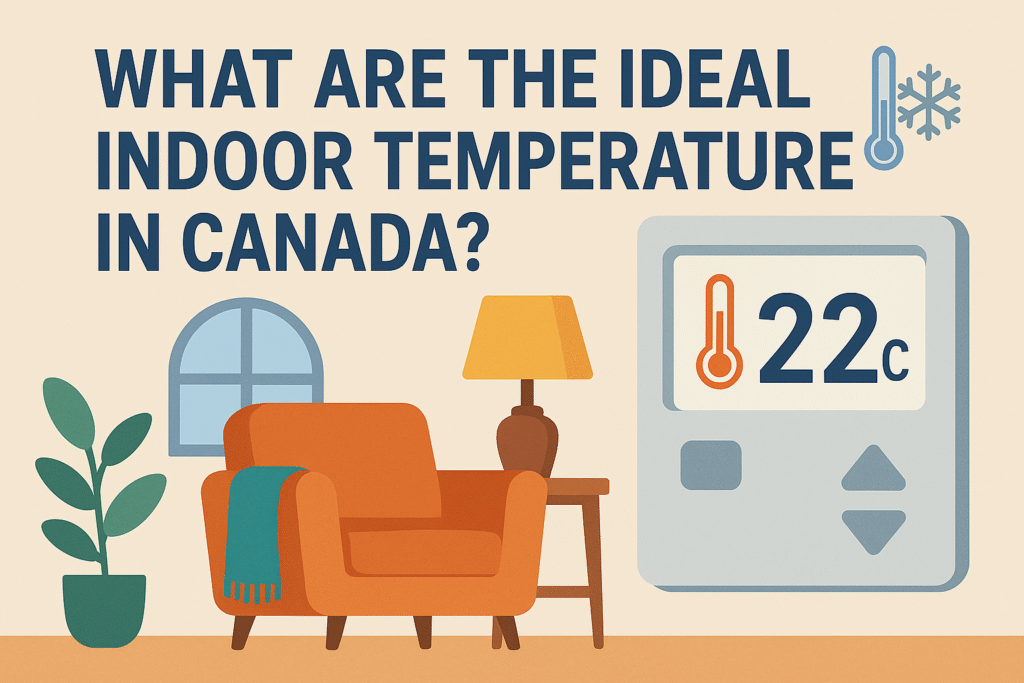Canada’s climate is as diverse as its landscapes, ranging from freezing winter winds to hot and humid summers. Whether you’re in Vancouver, Toronto, or Quebec, managing your indoor temperature year-round is crucial for comfort, energy efficiency, and overall well-being. In this guide, we’ll walk you through the ideal indoor temperatures in canada across all seasons in Canada, helping you navigate the challenges of extreme weather while optimizing your home’s energy use.
Common Indoor Air Quality Concerns in Canada
Maintaining the ideal indoor temperature isn’t just about comfort—it’s also closely tied to indoor air quality (IAQ). Many Canadian homeowners face several challenges when it comes to IAQ, which can affect both their health and comfort. Key concerns include:
- Temperature Extremes: Canada’s winter can see temperatures dropping below -30°C, while summers can sometimes surpass 30°C. These fluctuations require efficient heating and cooling solutions.
- Humidity Control: Winter heating often leads to dry indoor air, causing discomfort and even health issues. On the other hand, summer humidity can make your space feel stuffy and uncomfortable.
- Air Pollution: Outdoor pollutants can easily infiltrate your home, especially in cities with heavy traffic and industrial activity. Filtering these pollutants is essential to maintaining clean indoor air.
- Allergens: Pollen, dust mites, and pet dander are common allergens in Canadian homes, particularly during the spring and fall seasons.
At GM Heating and Cooling Inc., we specialize in maintaining healthy indoor air quality by offering tailored HVAC solutions that control temperature and humidity while keeping your indoor air fresh.
Ideal Indoor Temperatures in Canada for Your Comfort
The perfect indoor temperature varies based on the season and your comfort preferences. Below is a breakdown of ideal indoor temperatures for each season in Canada, factoring in energy efficiency and comfort.
Winter: Staying Warm Without Overheating
During Canada’s cold winters, heating your home efficiently is essential to staying warm without overburdening your heating system or causing your energy bills to skyrocket. The recommended indoor temperature during the winter months is between 18°C to 21°C (64°F to 70°F).
While it may be tempting to turn the thermostat up to higher levels, maintaining a balanced temperature helps preserve your system’s efficiency. Keep in mind that insulation, window sealing, and efficient HVAC systems are key factors in achieving and maintaining this optimal range.
- Energy Tip: Consider using a programmable thermostat to adjust temperatures when you’re not at home, reducing energy use.
- Health Tip: Dry air is a common issue in winter. Adding a humidifier or using a humidity control system can improve comfort and prevent issues like dry skin and irritated sinuses.
Transition Seasons: Spring and Fall – Balancing Comfort and Efficiency
The spring and fall months bring milder temperatures, but maintaining the ideal indoor temperature can still be challenging. The perfect temperature range for these seasons is typically 16°C to 20°C (61°F to 68°F).
With the unpredictability of weather, you may find yourself toggling between heating and cooling throughout the day. A smart thermostat can help manage these fluctuations while optimizing energy savings.
- Energy Tip: Use ceiling fans in the spring and fall to help circulate air naturally, keeping your home comfortable without turning on the A/C or heater.
Summer: Beating the Heat Without Overusing AC
Canada’s summer months can sometimes surprise residents with high temperatures, particularly in southern regions. To maintain comfort without running up your energy bill, aim to keep indoor temperatures between 23°C to 26°C (73°F to 79°F).
While air conditioners become essential in many homes, using them judiciously is key to avoiding high energy costs. It’s important to set your thermostat at a comfortable level while ensuring that your air conditioning system is properly maintained and efficient.
- Energy Tip: Close blinds or curtains during the day to block out the sun’s heat, reducing the need for excessive air conditioning.
- Health Tip: Excessive humidity in summer can make the air feel warmer than it is. An air conditioner with built-in dehumidification or a standalone dehumidifier can help reduce humidity levels and increase comfort.
The Ideal Indoor Temperature for Your House in Canada by Season
| Season | Ideal Indoor Temperature Range | Key Indoor Air Quality Considerations |
|---|---|---|
| Winter (Dec – Feb) | 18°C to 21°C (64°F to 70°F) | – Effective air filtration and purification – Humidity balance – Heating system maintenance |
| Transition Seasons (Spring and Fall) | 16°C to 20°C (61°F to 68°F) | – Controlled ventilation for fresh air – Allergen control (especially in spring) |
| Summer (Jun – Aug) | 23°C to 26°C (73°F to 79°F) | – Efficient air conditioner system – Humidity control – Air purification |
By setting your thermostat within these temperature ranges and optimizing your HVAC system, you can maintain a comfortable and healthy indoor environment throughout the year.
What Is the Best Temperature for an Empty House?
When leaving your house unoccupied, setting your thermostat to the right temperature can save energy without risking damage to your home. Here’s a guide on how to adjust the temperature depending on your absence:
Short-Term Absence (Up to a Few Days)
- Winter: Set the thermostat to 10°C to 13°C (50°F to 55°F) to prevent pipes from freezing.
- Summer: Set the thermostat to 28°C (82°F) to conserve energy.
Extended Absence (Several Weeks or More)
- Winter: Set the thermostat to 7°C to 10°C (45°F to 50°F) to prevent frozen pipes while minimizing heating costs.
- Summer: Set the thermostat to 32°C to 35°C (90°F to 95°F) to reduce energy consumption.
Using a smart thermostat can make managing these settings easy, as you can remotely adjust the temperature based on your travel schedule.
HVAC Service Solutions as Your Indoor Air Quality Partner
At GM Heating and Cooling Inc., we don’t just provide HVAC systems; we offer comprehensive solutions to maintain the perfect indoor temperature and air quality throughout the year. Here’s how we can assist:
- Humidity Control: Our systems help regulate indoor humidity, preventing discomfort during winter and controlling excess humidity in summer.
- HEPA Filtration: For allergy sufferers, our HEPA filtration systems remove dust, pollen, pet dander, and other allergens.
- Duct Cleaning: Over time, dust and debris build up in your HVAC ducts, which can affect air quality and system efficiency. Our duct cleaning services ensure your HVAC system operates at its best.
- Energy-Efficient Solutions: We specialize in designing energy-efficient HVAC systems that help reduce your energy bills while maintaining the perfect indoor climate.
With our wide range of services and expert knowledge, we are committed to enhancing your indoor comfort and well-being.
Conclusion
Maintaining the ideal indoor temperature in Canada requires understanding the challenges posed by the country’s diverse climate. Whether you’re navigating winter’s chill, the transition seasons, or summer’s heat, having an efficient HVAC system and understanding your temperature preferences is key to year-round comfort.
By adjusting your indoor temperature to the ideal range for each season, optimizing your HVAC system, and working with professionals like GM Heating and Cooling Inc., you can ensure that your home remains comfortable and energy-efficient. Contact us today to learn more about how we can help you achieve the perfect indoor environment.


